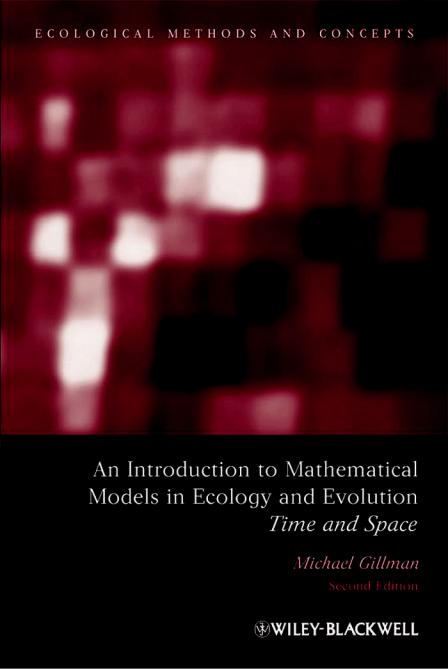
1gillman_m_an_introduction_to_mathematical_models_in_ecology
.pdf

An Introduction to Mathematical Models in Ecology and Evolution
Time and Space
SECOND EDITION
MICHAEL GILLMAN
Department of Biological Sciences
The Open University
Walton Hall
Milton Keynes
MK7 6AA
UK
A John Wiley & Sons, Ltd., Publication

AN INTRODUCTION TO
MATHEMATICAL MODELS IN
ECOLOGY AND EVOLUTION

ECOLOGICAL METHODS AND CONCEPTS SERIES
This series, successor to the Methods in Ecology series edited by John Lawton and Gene Likens, presents the latest ideas and techniques across the whole field of ecology and their application, from genetic to the global, from pest management to policy development. Books may be singleor multi-authored and will address emerging new areas within the field as well as updating well-established areas of endeavour. The new Series Editor is Professor Roger Kitching of Griffith University, Brisbane, who will welcome suggestions for works within the series. Email: r.kitching@griffith.edu.au
Ecological Methods and Concepts Series
Stable Isotopes in Ecology and Environmental Science
Second edition, 2007
Edited by Robert Michener and Kate Lajtha
An Introduction to Mathematical Models in Ecology and Evolution: Time and Space
Second edition, 2009
Michael Gillman
Forthcoming
Vegetation Classification and Survey
Andrew Gillison
Litter Decomposition in Aquatic Ecosystems
Edited by Mark Gessner
Canopy Science: Concepts and Methods
Edited by John Pike and James Morison
Methods in Ecology Series
Insect Sampling in Forest Ecosystems
2005
Edited by Simon Leather
Molecular Methods in Ecology
2000
Edited by Allan J Baker
Population Parameters: Estimation for Ecological Models
2000
Hamish McCallum
Biogenic Trace Gases: Measuring Emissions from Soils and Water
1995
Edited by PA Matson and RC Harriss
Geographical Population Analysis: Tools for the Analysis of Biodiversity
1994
Brian A Maurer

An Introduction to Mathematical Models in Ecology and Evolution
Time and Space
SECOND EDITION
MICHAEL GILLMAN
Department of Biological Sciences
The Open University
Walton Hall
Milton Keynes
MK7 6AA
UK
A John Wiley & Sons, Ltd., Publication

This edition first published 2009, © 2009 by Michael Gillman
Blackwell Publishing was acquired by John Wiley & Sons in February 2007. Blackwell’s publishing program has been merged with Wiley’s global Scientific, Technical and Medical business to form Wiley-Blackwell.
Registered office: John Wiley & Sons Ltd, The Atrium, Southern Gate, Chichester, West Sussex, PO19 8SQ, UK
Editorial offices: 9600 Garsington Road, Oxford, OX4 2DQ, UK
The Atrium, Southern Gate, Chichester, West Sussex, PO19 8SQ, UK 111 River Street, Hoboken, NJ 07030-5774, USA
For details of our global editorial offices, for customer services and for information about how to apply for permission to reuse the copyright material in this book please see our website at www.wiley.com/wiley-blackwell
The right of the author to be identified as the author of this work has been asserted in accordance with the Copyright, Designs and Patents Act 1988.
All rights reserved. No part of this publication may be reproduced, stored in a retrieval system, or transmitted, in any form or by any means, electronic, mechanical, photocopying, recording or otherwise, except as permitted by the UK Copyright, Designs and Patents Act 1988, without the prior permission of the publisher.
Wiley also publishes its books in a variety of electronic formats. Some content that appears in print may not be available in electronic books.
Designations used by companies to distinguish their products are often claimed as trademarks. All brand names and product names used in this book are trade names, service marks, trademarks or registered trademarks of their respective owners. The publisher is not associated with any product or vendor mentioned in this book. This publication is designed to provide accurate and authoritative information in regard to the subject matter covered. It is sold on the understanding that the publisher is not engaged in rendering professional services. If professional advice or other expert assistance is required, the services of a competent professional should be sought.
Library of Congress Cataloguing-in-Publication Data
Gillman, Michael.
An introduction to mathematical models in ecology and evolution : time and space / Michael Gillman. – 2nd ed.
p. cm. – (Ecological methods and concepts series)
Rev. ed. of: An introduction to ecological modelling / Michael Gillman, Rosemary Hails. 1997. Includes bibliographical references and index.
ISBN 978-1-4051-7515-9 (pbk. : alk. paper) – ISBN 978-1-4051-9489-1 (hbk. : alk. paper) 1. Ecology–Mathematical models. 2. Evolution (Biology)–Mathematical models.
I.Gillman, Michael. Introduction to ecological modelling. II. Title. QH541.15.M3G5 2009
577.01'5118–dc22
2008046481
A catalogue record for this book is available from the British Library.
Set in 9.5 on 12 pt Meridien by SNP Best-set Typesetter Ltd., Hong Kong
Printed and bound in Malaysia
1 2009

Contents
Preface, vi
1Introduction, 1
2Simple models of temporal change, 21
3Stochastic models, 44
4Modelling structured populations, 60
5Regulation in temporal models, 72
6Modelling interactions, 96
7Community models, 122
8Spatial models, 135 References, 149 Index, 157
v

Preface
This book is an introduction to the key methods and underlying concepts of mathematical models in ecology and evolution. It is intended to serve the needs of a broad range of undergraduate and postgraduate ecology and evolution students who need to access the mathematical and statistical modelling literature essential to their subjects. It assumes minimal mathematics and statistics knowledge (see below) while covering a wide variety of methods, many of which are at the forefront of ecological and evolutionary research. The book will also highlight the applications of modelling to practical problems such as sustainable harvesting and biological control.
There are many other ways in which this book could have been written and you will find examples of quite different treatments of modelling in the literature. In particular the book could focus on (and be lead by) applications, for example by asking whether models are helpful in understanding climate change or saving cod populations or reducing the incidence of malaria. The answer is yes to all of these but it was felt that it is better to try to understand the general principles underlying the models and then examine the applications. Doubtless my ideas of synthesis and generality are not those of others but it is an attempt to detect and reveal order. I also wanted to write a book with a lighter touch and so have avoided writing lengthy descriptions of method. Hopefully this makes the book accessible to a wider readership.
Understanding of the text will be helped by a familiarity with the basics of the following mathematical and statistical methods and concepts:
•manipulation of algebraic equations,
•logarithms and powers,
•differentiation,
•variance and standard error,
•significance and hypothesis testing.
Many thanks to Hils and Ed for encouragement and valuable comments. I have learnt much from interactions with colleagues at the Open University and previously at Imperial College. My interest in mathematical models was inspired by the lectures of Brian Goodwin and John Maynard Smith.
Michael Gillman
September 2008
vi

CHAPTER 1
Introduction
1.1 What is a model?
A model is some representation of reality. In everyday life we are familiar with physical models of reality such as toy cars and film sets. Physical models have also been used extensively in science, perhaps most famously as the ball-and-stick model of DNA by Crick and Watson. Such physical models have been largely replaced by computer images and/or mathematical representations. In ecology and evolution the models are almost entirely of a mathematical nature. Reference to models and modelling in this book can therefore be read as mathematical models or modelling. Fortunately we do not have to be highly skilled mathematicians to construct and use such models. This text will show how to develop ecological and evolutionary models which have a wide application across the life sciences and are relevant to many other branches of science. Indeed, the understanding of modelling benefits from interplay between the sciences.
An important first step is to understand the overlap between statistical analysis and mathematical modelling. One of the central aims of statistical analysis is the description of trends and distributions in sets of data. For example, we might wish to provide a description of the change over time in the average size of a population. We can do this by using the statistical method of regression which provides a mathematical description of a line or curve of best fit through the data. The equation of the resulting line or curve is also a mathematical model of the population and could be used to predict change over time, with the possibility of extrapolating beyond the last time point. Of course, we need to be cautious over the extent to which extrapolations are performed, or, at the very least, make the user aware of the possible problems. Regression is introduced in the next section. A mathematical summary that allows prediction and extrapolation is therefore one valuable use of models. Expressing the model as a mathematical formula provides a brevity and formality of description. It also allows manipulation of the model and provides the opportunity for discovery of emergent properties not apparent from non-mathematical reasoning. Another related use of models is that they allow a simplification of reality. An alternative to producing models from observed temporal or spatial data is that we can build them from
1
